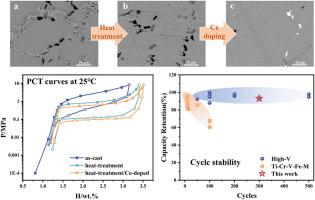Improved hydrogen storage capacity and cyclic properties of TiCr(FeV80) alloys by heat treatment and Ce doping
IF 8.1
2区 工程技术
Q1 CHEMISTRY, PHYSICAL
引用次数: 0
Abstract
V-based BCC solid solution alloys stand out for their exceptional hydrogen storage capacity at room temperature, yet they encounter obstacles in reversibility, cost-efficiency, and stability, hindering their widespread applications. In this work, a low-cost and high-performance Ti31Cr35(FeV80)34 alloy was prepared by heat treatment and Ce doping with an effective dehydriding capacity of 2.28 wt% and a capacity retention rate of 93.2% after 300 cycles. Analysis using XRD and SEM reveals that heat treatment significantly reduces the accumulation of the C14 Laves phase, while Ce doping mitigates the accumulation of Ti-rich phases, thereby enhancing the compositional uniformity of the alloy. Notably, after heat treatment and Ce doping, the slope factor in the PCT curve has dropped significantly from 1.58 to 0.36, leading to an increase in reversible hydrogen storage capacity from 2.03 to 2.28 wt%. Furthermore, the dehydriding enthalpy value of the Ti31Cr35(FeV80)34 alloy has decreased from 39.16 to 37.91 kJ/mol. Remarkably, the cycling performance of the alloy, following 1 wt% Ce doping, exhibits excellent stability. This stability is primarily attributed to the enhancement of the alloy's powdering resistance through Ce doping, which also preserves the metallic state content of Ti, Cr, and V during the cycling process. This advancement holds significant promise for the development of cost-effective and reliable hydrogen storage alloys.

通过热处理和掺杂 Ce 提高 TiCr(FeV80)合金的储氢能力和循环特性
钒基 BCC 固溶体合金在室温下具有优异的储氢能力,但在可逆性、成本效益和稳定性方面存在障碍,阻碍了其广泛应用。本研究通过热处理和掺杂 Ce 的方法制备了一种低成本、高性能的 Ti31Cr35(FeV80)34 合金,其有效脱水容量为 2.28 wt%,循环 300 次后容量保持率为 93.2%。利用 XRD 和 SEM 进行的分析表明,热处理显著减少了 C14 Laves 相的积累,而 Ce 掺杂则减轻了富钛相的积累,从而提高了合金的成分均匀性。值得注意的是,经过热处理和掺杂 Ce 后,PCT 曲线的斜率因子从 1.58 显著下降到 0.36,从而使可逆储氢能力从 2.03 wt% 提高到 2.28 wt%。此外,Ti31Cr35(FeV80)34 合金的脱水焓值从 39.16 kJ/mol 降至 37.91 kJ/mol。值得注意的是,在掺入 1 wt% Ce 后,合金的循环性能表现出卓越的稳定性。这种稳定性主要归功于通过掺杂 Ce 提高了合金的抗粉化性能,同时在循环过程中保持了 Ti、Cr 和 V 的金属态含量。这一进步为开发具有成本效益且可靠的储氢合金带来了重大希望。
本文章由计算机程序翻译,如有差异,请以英文原文为准。
求助全文
约1分钟内获得全文
求助全文
来源期刊

International Journal of Hydrogen Energy
工程技术-环境科学
CiteScore
13.50
自引率
25.00%
发文量
3502
审稿时长
60 days
期刊介绍:
The objective of the International Journal of Hydrogen Energy is to facilitate the exchange of new ideas, technological advancements, and research findings in the field of Hydrogen Energy among scientists and engineers worldwide. This journal showcases original research, both analytical and experimental, covering various aspects of Hydrogen Energy. These include production, storage, transmission, utilization, enabling technologies, environmental impact, economic considerations, and global perspectives on hydrogen and its carriers such as NH3, CH4, alcohols, etc.
The utilization aspect encompasses various methods such as thermochemical (combustion), photochemical, electrochemical (fuel cells), and nuclear conversion of hydrogen, hydrogen isotopes, and hydrogen carriers into thermal, mechanical, and electrical energies. The applications of these energies can be found in transportation (including aerospace), industrial, commercial, and residential sectors.
 求助内容:
求助内容: 应助结果提醒方式:
应助结果提醒方式:


